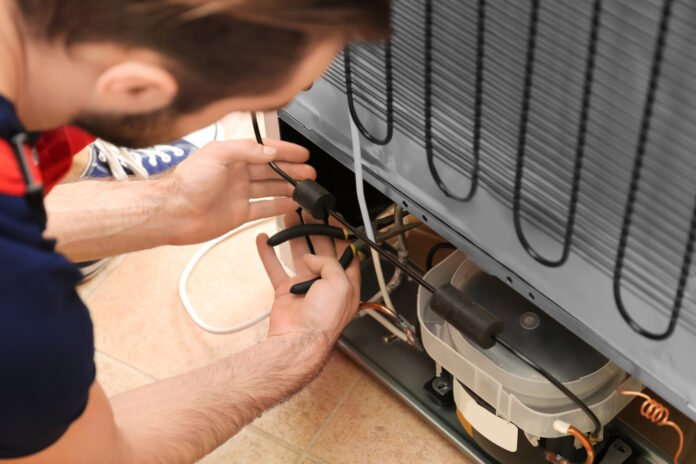Introduction
In the modern home, two essential appliances are the refrigerator and dishwasher. These remarkable inventions have transformed our daily lives, preserving our food and sparing us from the drudgery of handwashing dishes. This extensive article will embark on a comprehensive journey into the inner workings, history, maintenance, and professional repair services for both appliances. By understanding these kitchen stalwarts deeper, you’ll be better equipped to make informed decisions, ensuring they serve you faithfully for years.
Part I: The Refrigerator – Preserving Freshness, One Degree at a Time
Refrigerator Types
Refrigerators come in various styles, each catering to distinct needs and kitchen layouts. From the classic top-freezer model to the sleek built-in units, we’ll explore the pros and cons of each type.
- Top-Freezer Refrigerators: This classic style features the freezer compartment on top and the refrigerator below. It offers simplicity and cost-effectiveness, making it a popular choice for many households. The top freezer design provides ample fresh food storage, but the freezer section may not be as spacious as in other models.
- Bottom-Freezer Refrigerators: In these models, the freezer is located at the bottom, placing the refrigerator section at eye level. This design makes it easier to access fresh food items without bending down. The freezer drawer typically slides out, offering convenient storage. Bottom-freezer refrigerators are gaining popularity for their ergonomic layout.
- Side-by-Side Refrigerators: Side-by-side models have the freezer and refrigerator compartments next to each other, offering a balanced layout with ample storage space on both sides. They often come with advanced features like water and ice dispensers on the door.
- French Door Refrigerators: These popular models feature two side-by-side refrigerator doors on top and a bottom freezer drawer. French door refrigerators are known for their spacious interiors, adjustable shelves, and advanced features. They often have the freezer section divided into pull-out drawers, making organizing and accessing frozen items easy.
- Compact and Mini Refrigerators: Ideal for small apartments, dorms, or supplementary fridges, these units offer a compact design with essential cooling capabilities. They’re perfect for keeping beverages and a limited amount of food cold.
- Built-in and Counter-Depth Refrigerators: These refrigerators are designed to seamlessly integrate into kitchen cabinetry for a sleek, customized appearance. Built-in models often have panel-ready fronts to match your kitchen’s decor. Counter-depth refrigerators are designed to align with standard countertops for a streamlined look.
Each refrigerator type has its advantages and considerations, making it essential to choose the one that best suits your kitchen space and lifestyle.
The Importance of Refrigerator Maintenance
A solid maintenance routine is essential to ensure your refrigerator operates efficiently and lasts for years. Learn the ins and outs of temperature control, cleaning the condenser coils, and checking door seals. Discover how organization and innovative loading can further enhance your fridge’s performance.
- Temperature Control: The temperature inside your refrigerator should ideally be set between 35°F and 38°F (1.7°C to 3.3°C), while the freezer should be maintained at 0°F (-17.8°C) for optimal cooling and food preservation. Invest in a refrigerator thermometer to periodically check and adjust the temperature settings.
- Cleaning the Condenser Coils: Over time, dust and debris can accumulate on the condenser coils on the back or bottom of the refrigerator. This buildup hinders the coils’ ability to dissipate heat efficiently, making your refrigerator work harder to maintain the desired temperature. To avoid this, it’s essential to vacuum or brush the coils every 6 to 12 months. Be sure to unplug the refrigerator or turn off the power at the circuit breaker before cleaning the coils for safety.
- Checking Door Seals: The rubber gaskets or door seals create an airtight seal when the refrigerator doors are closed. A damaged or worn seal can lead to temperature fluctuations and increased energy consumption. Periodically inspect the seals for wear, cracks, or tears. An easy way to test the seal’s effectiveness is to place a dollar bill between the gasket and the door and close it. If you can easily pull out the dollar bill without resistance, it’s time to replace the seal.
- Proper Organization and Smart Loading: How you organize and load your refrigerator can significantly impact efficiency. Here are some tips:
- Store raw meats and seafood on the lower shelves to prevent cross-contamination in case of leaks.
- Keep dairy products and eggs in the coldest part of the refrigerator, usually the back of the top shelf.
- Store fruits and vegetables in the designated crisper drawers, adjusting the humidity settings.
- Allow hot foods to cool down to room temperature before placing them in the refrigerator to prevent the appliance from working harder to lower the temperature.
- Use airtight containers or covers for leftovers to prevent odors from permeating the fridge.
By following these maintenance guidelines, you can extend the lifespan of your refrigerator and ensure it continues to operate efficiently, keeping your food fresh and safe for consumption.
Refrigerator Repair: Navigating Cooling Challenges
Refrigerators can encounter issues such as temperature fluctuations, leaks, and ominous noises despite regular maintenance. Recognizing the signs of trouble and knowing when to seek professional refrigerator repair services is vital to keep your food fresh and your kitchen running smoothly.
Common Refrigerator Issues and Their Causes:
- Temperature Fluctuations: If you notice inconsistent temperatures inside your refrigerator or freezer, it can be caused by various factors. A malfunctioning thermostat, a faulty defrost timer, or a blocked airflow due to excess frost buildup can all lead to temperature fluctuations.
- Leaking Water: A refrigerator leak can result from a clogged defrost drain, a cracked water supply line, or a malfunctioning water inlet valve. It’s crucial to address leaks promptly to prevent water damage and mold growth.
- Unusual Noises: Odd noises emanating from your refrigerator can be unsettling. Common culprits include a malfunctioning evaporator fan motor, a noisy compressor, or a damaged condenser fan motor.
- Ice Maker Problems: If your refrigerator has an ice maker and it stops working, it could be due to issues with the water supply, a defective water inlet valve, or a malfunctioning ice maker itself.
- Frost Buildup: Excessive frost buildup in the freezer can interfere with proper cooling. A faulty defrost timer may cause it, a malfunctioning defrost heater, or a damaged defrost thermostat.
- Condensation Inside the Fridge: If you notice condensation forming inside your refrigerator, it can be due to several factors, including a damaged door seal, high humidity levels, or a blocked drain tube.
When facing any of these issues, it’s essential to exercise caution and prioritize safety. Here are some general steps to follow:
- Safety First: Before attempting any repairs or troubleshooting, unplug the refrigerator or turn off the power at the circuit breaker to ensure your safety.
- Consult the Manual: Refer to your refrigerator’s user manual for troubleshooting tips and specific instructions for your model.
- Simple Solutions: Sometimes, the issue may have a simple solution, such as adjusting the temperature settings or cleaning a clogged drain. Always start with the most straightforward solutions before delving into more complex repairs.
- Professional Help: If you cannot identify or resolve the problem, it’s best to seek professional refrigerator repair services. Experienced technicians have the knowledge and tools to diagnose and fix various refrigerator issues safely and efficiently.
Professional Refrigerator Repair Services: Trusting the Experts
While some minor refrigerator issues can be resolved with DIY efforts, complex problems and significant malfunctions require the expertise of trained technicians. Professional refrigerator repair services offer numerous advantages:
- Accurate Diagnosis: Experienced technicians can quickly identify the root cause of refrigerator issues, preventing unnecessary repairs and saving you time and money.
- Quality Repairs: Professionals use genuine replacement parts and ensure that repairs are conducted to the highest standards, extending the life of your appliance.
- Cost-Effective: Timely repairs can prevent minor issues from escalating into significant problems, potentially saving you money in the long run.
- Convenience: Repairs are handled efficiently, minimizing the downtime of your refrigerator and reducing the inconvenience of storing food elsewhere.
- Safety: Refrigerators contain complex electrical and refrigeration systems that can pose safety risks when tampered with by untrained individuals. Professional technicians are well-equipped to handle these systems safely.
The Dishwasher – Liberation from the Sink
Dishwashers: A Revolution in Kitchen Cleanup
The dishwasher’s journey from the early hand-cranked contraptions to today’s automated wonders has liberated countless hours of kitchen labor. Uncover the story of Josephine Cochrane’s ingenious invention that led to the modern dishwasher.
The history of dishwashing machines can be traced back to the 19th century when hand-cranked devices were developed to automate the process. However, These early machines needed to be more efficient and primarily used in commercial settings.
The breakthrough in dishwasher technology came in 1886 when American inventor Josephine Cochrane patented the first practical automatic dishwasher. Her invention used water pressure and a wheel to propel water onto the dishes, ensuring thorough cleaning. The device was a significant leap forward in kitchen technology and marked the beginning of the modern dishwasher era.
Dishwasher Types
Dishwashers come in various configurations, catering to different kitchen layouts and space constraints. Explore the merits of top-loading, front-loading, compact, and portable models to find the perfect fit for your needs.
- Top-Loading Dishwashers: These dishwashers have the traditional design of a top-loading washing machine, with the door on the top. They are typically more affordable and can be a good option with limited space.
- Front-Loading Dishwashers: Front-loading dishwashers have a door that opens from the front, similar to most washing machines. They offer a sleek and integrated look in your kitchen, often with advanced features like hidden controls and adjustable racks.
- Compact Dishwashers: Compact dishwashers are smaller, making them suitable for small kitchens, apartments or as a supplementary dishwasher in larger households. They can be built into cabinetry or placed on countertops.
- Portable Dishwashers: They are freestanding units on wheels, making them easy to move and install wherever you have a water source and electrical outlet. They are an excellent choice if you have limited kitchen space or want the flexibility to move the dishwasher.
The choice of dishwasher type depends on your kitchen layout, available space, and personal preferences. Consider the size of your household and the frequency of dishwashing when deciding.
The Importance of Dishwasher Maintenance
Maintaining your dishwasher ensures sparkling clean dishes and extends its lifespan. Dive into the details of filter cleaning, interior maintenance, detergent selection, and other pro tips for dishwasher care.
- Clean the Filter: Most dishwashers have a filter or trap that captures food particles and debris during the wash cycle. Over time, this filter can become clogged, affecting the dishwasher’s performance. Regularly remove and clean the filter according to the manufacturer’s instructions.
- Inspect Spray Arms: The dishwasher’s spray arms are responsible for evenly distributing water for effective cleaning. Check for clogs or debris in the spray arm nozzles and ensure they can rotate freely.
- Clean the Interior: Wipe down the dishwasher’s interior, including the door gasket and detergent dispenser, to prevent the buildup of soap scum and food residue.
- Use Quality Detergent and Rinse Aid: Choose a high-quality dishwasher detergent and rinse aid to ensure optimal cleaning and drying results. Follow the manufacturer’s recommendations for detergent quantity.
- Load Dishes Properly: Proper loading of dishes can significantly impact cleaning results. Avoid overloading the dishwasher, and ensure that words are spaced apart to allow water and detergent to reach all surfaces.
- Check and Maintain the Water Supply: Ensure the dishwasher has a steady and adequate hot water supply. Check the water inlet valve and hoses for any leaks or blockages.





